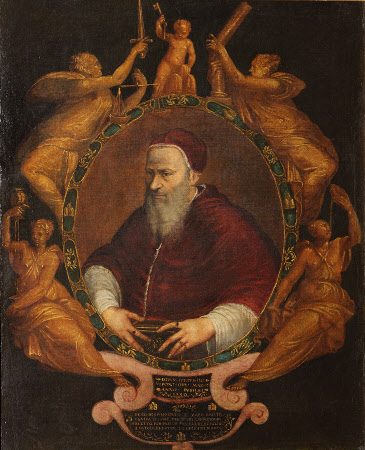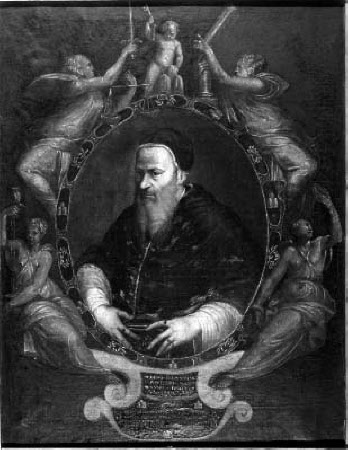Allegorical Portrait of Pope Julius III (Giovanni Maria de' Ciocchi del Monte) (1487-1555)
Italian (Roman) School
Category
Art / Oil paintings
Date
1500 - 1599
Materials
Oil on canvas
Measurements
546 x 432 mm (21 1/2 x 17 in)
Place of origin
Rome
Order this imageCollection
Attingham Park, Shropshire
NT 608978
Caption
The oval surround of this portrait is decorated with four allegorical figures representing the cardinal virtues: Justice, holding a sword and scales; Fortitude holding a sword and a pillar; Prudence holding a snake and a mirror; and Temperance pouring liquid from one vessel to another. As a true Renaissance pope, Julius III (1487-1555) enjoyed hunting, banqueting, the theatre and, in particular, advancing the interests of his family. He created a scandal when he became enamoured of a fifteen-year-old boy whom he picked up in the streets of Parma. He arranged for his brother to adopt him, and later made him a cardinal. However, because of his formidable criminal activities the boy was finally thrown into prison. Julius was one of the three delegates to the Council of Trent, which he reopened after his election with the support of the emperor Charles V. He also appointed Michelangelo as chief architect of St Peter’s, Rome.
Summary
Oil painting on canvas, Allegorical Portrait of Pope Julius III (Giovanni Maria de' Ciocchi del Monte) (1487-1555), Italian (Roman) School, 16th century.A half-length portrait, in a painted oval, turned slightly to left, holding a casket (?). The oval surround of the portrait is decorated with gilt allegorical figures and surmounted by the Pope's arms. Inscribed in cartouche under portrait: DIVUS JVLIVS III / PONT OPT MAX ANNO JVBILEI / 1550….(followed by a laudatory inscription). The sitter was Pope from 8 February, 1550 to 23 March, 1555. Born Giovanni Maria de’ Ciocchi del Monte in Rome, he became Bishop of Pavia, and twice served as Governor of Rome. He succeeded his uncle as archbishop of Siponto, and was cardinal-priest in the title of Santi Vitalis, Gervase and Protase, and cardinal-bishop of Palestrina. He was crowned on 22 February 1550 and took possession of the Lateran Basilica, the Pope’s cathedral church on 24 June 1550. As a true Renaissance pope, he enjoyed hunting, banqueting and the theatre and naturally advanced the interests of his family. He created a great scandal by becoming enamoured of a fifteen-year-old boy whom he picked up in the streets of Parma and arranged for his brother to adopt. He then made him a cardinal and head of the Secretariat of State! Because of his formidable criminal activities the boy was finally thrown into prison. Julius was one of the three delegates to the Council of Trent, which he reopened after his election with the support of the emperor Charles V. Henry II of France forbade French participation and the Council was suspended due to the German/French war. The Papal and Imperial forces were defeated by the French and Charles V was forced to withdraw his patronage. Julius retired to his luxurious Villa Giulia in Rome and spent his time in pleasurable pursuits with occasional interruptions for Church business. He appointed Michelangelo as chief architect for the new St Peter’s, the composer Palestrina as choirmaster of the Capella Giulia in St Peter’s and confirmed the constitution of the Jesuits. On the accession of Mary Tudor in 1553, he sent Cardinal Reginald Pole to organise the reunion of England with the Church of Rome which Pole commenced by absolving England from the papal interdict placed upon it by Paul III. Julius died from gout and was buried in the crypt of St Peter’s, Rome.
Provenance
Attingham collection. 1913 Inventory p.64; bequeathed to the National Trust with the estate, house and contents of Attingham by Thomas Henry Noel-Hill, 8th Baron Berwick (1877-1947) on 15th May 1953.
Credit line
Attingham Park, The Berwick Collection (National Trust)
Marks and inscriptions
In cartouche under portrait, on the front: Divus Julius III Pont opt max anno Jubilei 1550... (inscription, followed by laudatory inscription). On stretcher (middle): Attingham Park P/42 Roman School, Pope Julius III (on label) On stretcher (bottom): ATT/P/042 (in pink chalk) On back of frame (top): Attingham Park P/42 Roman School, Pope Julius III (on label) On back of frame (top): Attingham On back of frame (left): 21 On back of frame (bottom): ATT/P/042 (in pink chalk)
Makers and roles
Italian (Roman) School, artist

